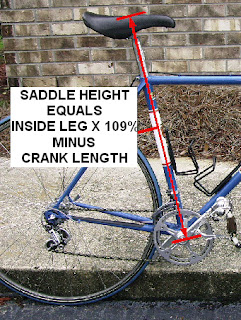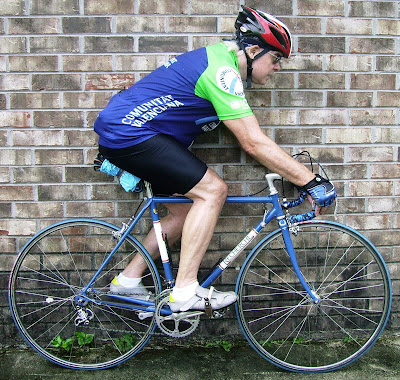Saddle Height
 Fri, September 14, 2007
Fri, September 14, 2007 When it comes to bike fit everyone is looking for a magic formula. There isn’t one, because there are so many variables in the human body.
This doesn’t mean that formulas are of no use. As long as we accept their limitations, they can often be a good place to start.
An extensive study on bicycle design was done at Loughborough University (Pronounced Luff-boro.) in England in the mid 1970s. Part of their report stated that saddle height, measured from the pedal surface to the top of the saddle, was equal to 109% of a rider’s inside leg measurement.
The way they arrived at this 109% was by measuring the inside leg of a large number cyclists, and at the same time measured the height of their saddles. 109% was the average; in reality, most of the cyclists measured would have been above or below this percentage. This is the nature of averages.
The 109% is a place to start; the saddle height for most people is going to be slightly up or down from this. I like the idea of a percentage because the longer a rider’s legs, their saddle is going proportionately higher. This means a greater distance from the saddle to the handlebars, (Drop.) which is what the larger rider needs.
Inside leg measurement is something that causes confusion; in America, (Always trying to abbreviate the English language.) it is referred to as “inseam.” People become confused with pant size which is not surprising because pants have a seam, legs do not.
I have also heard talk of “Pubic bone height.” (PBH) The pubic bone is part of the skeleton and I don’t see how you can measure its height without x-rays. I always measured inside leg from the perineum to the floor, without shoes.
The perineum in simple non medical terms is the fleshy part that is in contact with the saddle. I usually say, “Crotch to floor without shoes,” but I am trying to eliminate all confusion here.
The way I would measure someone was first have the customer pull their pants up tight into their crotch to get an accurate measurement. Place the end of a steel tape measure firmly against the perineum, and measure down the inside of one leg to the floor.
If you are not sure of your inside leg measurement, the most accurate way is to have someone measure you in the way I have just described.
Let’s use for example an inside leg of 33 inches. If you don’t have a metric tape measure, it is 33 x 2.54 = 84 cm. (Rounded to the nearest centimeter.)
84 x 109% = 91.5 cm. Remember this is the measurement from the pedal surface in its lowest position to the top of the saddle. Deduct the crank length so you can measure from the center of the bottom bracket, which is easier. 175 cranks are in mm. so deduct 17.5 cm. from 91.5 = 74 cm. (See picture, left.)
Deduct the crank length so you can measure from the center of the bottom bracket, which is easier. 175 cranks are in mm. so deduct 17.5 cm. from 91.5 = 74 cm. (See picture, left.)
I realize the distance to the pedal face is less than the crank length, but remember this is only a starting place. The saddle height will still need adjustment by actual riding experimentation.
The reason everyone with a 33 inch inside leg will not have the same saddle height is partly because of different shoe sizes. (Foot length.) A rider’s toe is pointing downwards at the bottom of a pedal stroke, a person with a longer foot needs the saddle higher, and vice versa for small feet.
Other factors effecting saddle height are the width of the rider’s pelvic bones, the width of the saddle, and whether the saddle is firm or soft.
Take a test ride, and if you can’t tell if the saddle is too high, or too low, raise it ¼ inch (6 mm.) and try again. It is easier to tell if a saddle is too high, rather than if it is too low. It is best to start on the high side and work down.
If the saddle is too high you will feel like you are stretching at the bottom of the pedal stroke, in extreme cases you will be rocking from side to side on the saddle. Come down a ¼ inch.
To pedal efficiently, legs need to move straight up and down like two pistons. The hip joint, like all joints, has a limit to its upper movement. To demonstrate this to yourself, stand in a doorway and support yourself, while lifting one knee as high as you can and hold it there with the other hand.
This is the upper limit to your hip movement. The only way you can make you knee go higher is to swing your upper leg outward, and your knee will then go another inch or so higher.
When pedaling, you do not want your legs splaying outwards at the top of each stroke; this is not an efficient way to pedal. If this is happening, your saddle is too low, too far back, or a combination of the two.
Leaning forward restricts your hip movement still further. Sit on the bike, leaning against a wall or a vehicle for support. In your lowest tuck position, see if you can lift your foot above the pedal when it is at the top of its stroke. In other words, you do not want to be at the absolute limit of your hip joint’s movement at the top of each pedal stroke.
Once you have your saddle set right, ride it for at least two weeks to become used to it. Then you can experiment by raising it small amounts 1/8 inch. (3 mm.) at a time. Ask yourself, “Does this feel better, or worse?”
Often raising the saddle slightly will immediately make you feel more powerful in your pedal stroke, and stronger while climbing. As the season progresses, you gain fitness, you loose fat from your backside, and muscles stretch, the saddle may need to go up again.
 Dave Moulton | Comments Off |
Dave Moulton | Comments Off |  Bike Fit
Bike Fit 




















